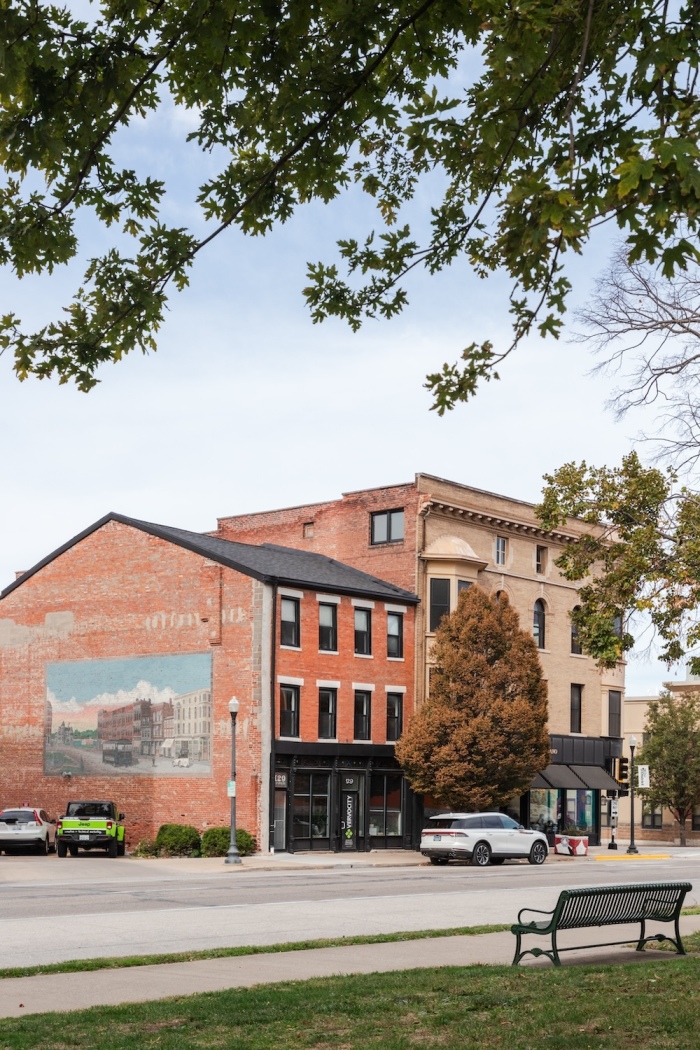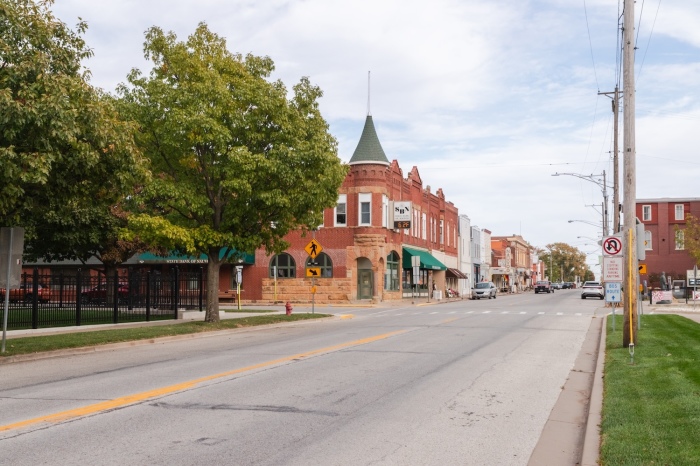Few places along the Mississippi River tell the story of America’s faith as vividly as Quincy, a river town perched atop a bluff in the westernmost tip of Illinois.
Founded in 1825 and named after President John Quincy Adams, Quincy, the county seat of Adams County, was carved out of the Illinois prairies by Yankees who migrated west from New England to upstate New York. Early settlers retained Whig politics, abolitionist beliefs, and Protestant work ethics. Their traces are still visible today. Even the name of the local newspaper, the Herald Whig, recalls the old Yankees.
Home to 39,463 souls, this city has been the center of religious and moral conflicts many times. In 1838 and 1839, Mormons crossed the Mississippi River from Missouri to escape persecution. Abolitionists then made Quincy an important stop on the Underground Railroad.

Joseph Smith, founder of the Mormon Church, or The Church of Jesus Christ of Latter-day Saints, and many of his followers took refuge here after being subjected to what today would undoubtedly be called genocide.
In the midst of one of the darkest chapters in American history, the people of Quincy demonstrated compassion and charity. They opened their doors to sanctuaries in churches, homes, and community centers until the Mormons established a new settlement in a largely undesirable swamp about 45 miles upriver in neighboring Hancock County.
Nauvoo, as Smith named his new settlement, was chartered as a city by 1840 and within a few years rivaled the population of Chicago. But prosperity and tolerance were short-lived. The rapidly growing and increasingly insular Mormon community alarmed non-Mormons.

By 1844 tensions were high. Smith and his brother were murdered by a mob while being held in the county jail in Carthage, the county seat of Hancock County. For Mormons, Smith’s death was seen as an act of martyrdom, the last of a religious leader who undoubtedly reshaped America’s religious landscape. It also ended Mormon ambitions in Illinois. Within two years, more than 12,000 non-Christian believers began the long overland journey to present-day Salt Lake City, Utah, using what became the California, Mormon, and Oregon Trails.
Today, Nauvoo (population 950) consists of a quaint downtown, mostly late 19th-century buildings, and a historic district on the banks of the Mississippi River, with a mix of restored and rebuilt Mormon-era buildings.
The most famous building is the Nauvoo Temple. This is a Greek Revival building modeled after a temple that was in ruins after the Mormon exodus. Located next to St. Roman Catholic Parish Church. Peter and Paul, by contrast, are modest, if not conspicuous. In Mormonism, temples are reserved for specific rituals and rituals. Though often comparable in size to Christian cathedrals, temples are closed to non-Mormons once consecrated.
This historic district, reminiscent of Colonial Williamsburg, is primarily owned by the Utah-based Church of Jesus Christ of Latter-day Saints. But the graves of Smith, his wife and brother belong to the Community of Christ, a small branch of Mormonism that has been reconstituted in recent years as Trinitarianism.

About 40 miles east of Carthage is the old Hancock County Jail. It is also owned by the LDS and has been restored to its original appearance in 1844, when Smith and his brother were murdered.
Although many of those who visit Nauvoo and Carthage are Mormons on religious pilgrimages, the stories found here are useful to non-Mormons as well. The guides, dressed in vaguely period costumes, may be devout Mormons, but they’re not proselytizing.
Returning to Quincy, the city’s conscience was once again tested in the years leading up to the Civil War. It was then that residents, against federal law, helped enslaved people travel north in search of freedom.
It was here in 1858 that Abraham Lincoln and Stephen A. Douglas met for the sixth of seven debates in Washington Park, a landmark square still located downtown. Thousands gathered to hear Lincoln attack slavery and oppose its expansion.
Dubbed the City of Jewels, the city grew rapidly during the decades of the 1800s. This growth is reflected in the architecture we see today.
Pre-Civil War Greek Revival homes, rowhouses with prominent bay windows, and early-last-century Queen Anne brownstones sit just blocks from warehouses and other commercial buildings. Then there are Anglican-turned-Anglican churches, Congregationalists, Evangelicals, Reformed, Disciples of Christ, Methodists, Lutherans, Presbyterians, and Roman Catholics. Many churches seem to practice some kind of architectural one-manship, with newly built churches being slightly larger or featuring more grandiose details than their predecessors.
The notable architecture isn’t entirely from the 1800s. It’s home to notable mid-century modern buildings, including the Church of St. Boniface. It replaced the previous building used by Ven. Augustus Tolton was the first black Roman Catholic priest in the United States.
Once located on the edge of the frontier, where the Mississippi River served as a gateway to westward expansion, Quincy has waxed and waned during its two centuries of existence. Once upon a time, a literal man passed through Quincy on a river steamboat.

Geographically Midwestern, historically Yankee, but its true identity can be difficult to discover. To my Michigan ears, the English spoken here sounds a little Southern, a little Appalachian. Surrounding Adams County and adjoining Hancock and Pike counties, on the other hand, feel as rural as ever.
Still, despite its modest population and significant decline in rusting industrial areas, Quincy continues to outperform its size. These visitors include six U.S. presidents: Rutherford B. Hayes in 1879, William McKinley in 1899, Theodore Roosevelt in 1903, Jimmy Carter in 1979, Bill Clinton in 2000, and Barack Obama in 2010.
If you go
The Plaza History Museum is housed in Quincy’s castle-like Richardsonian Romanesque Old Public Library. Although small, the collection is fascinating, especially the stained glass from local churches and exhibits about the black Roman Catholic priest Tolton. Business hours are Tuesday through Saturday from 10 a.m. to 4 p.m. Admission is free. Other Quincy must-sees include the Subway Museum, the home of John Wood (Quincy founder and future Governor of Illinois), the Lincoln-era log cabin village, and the Quincy Museum.
The Mormon Church operates two visitor centers in historic Nauvoo. Both are open daily. The North Center is open Monday through Saturday, 10 a.m. to 4 p.m., and 12 p.m. to 4 p.m. Sunday and Southcenter is open daily from 9 a.m. to 5 p.m. On Sundays, the hours are 12:00pm to 5:00pm. Admission to historic Nauvoo is free. Parking is also free.
Quincy is accessible by plane, but service is limited. Additionally, you will need a car to explore this area. Quincy is approximately 130 miles north of St. Louis and approximately 300 miles southwest of Chicago by land.
The Atrium Hotel on Third, formerly a Holiday Inn, is undergoing extensive renovations before flying the flag under Hilton’s DoubleTree brand. Once renovations are complete, this will be the place to stay in downtown Quincy. At least, until 2027 when the former Downtown Bank opens as a boutique hotel.
I stayed further out in the suburbs at a now franchised Holiday Inn, surrounded by strip malls and big box stores. Renovated in the last year or two, this is a nicer-than-average Holiday Inn with a delicious all-day restaurant.
If you want to spend the night in Nauvoo, stay in one of the 1840s-era rooms at the Hotel Nauvoo Historic Inn & Restaurant. Please note that this property will be closed for winter on November 8th.
Recommended restaurants in Quincy include Patio Restaurant & Lounge, Tiramisu, and Boudal Steakhouse. Boudal Steakhouse is located in a vintage building overlooking the Mississippi River.
Dennis Lennox writes a travel column for The Christian Post.
